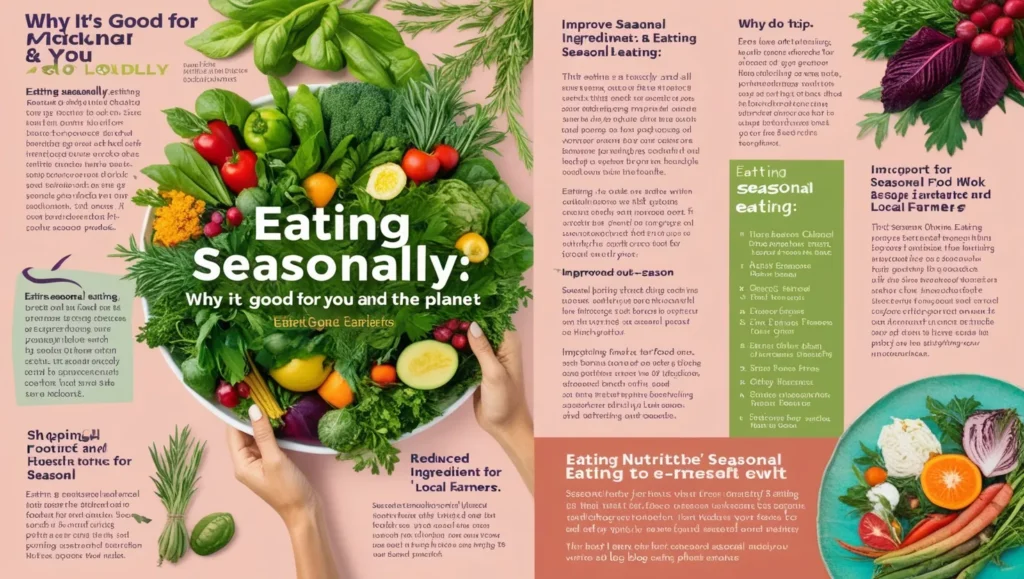Eating Seasonally Why Its Good for You and the Planet
In a world where supermarkets stock strawberries in December and asparagus in October, eating seasonally may seem like an old-fashioned concept. However, this age-old practice is experiencing a renaissance as people become more mindful of their health and the environment. Eating seasonally means consuming fruits, vegetables, and other foods that are naturally harvested at their peak during specific times of the year. This seemingly simple choice carries profound benefits for our health, our taste buds, and the planet.
1. What Does Eating Seasonally Mean?
Eating seasonally is about aligning your diet with nature’s rhythm. It means enjoying produce that is locally grown and harvested at its natural time of year. For example:
- Spring: Tender greens, asparagus, and strawberries.
- Summer: Juicy tomatoes, sweet corn, and watermelons.
- Autumn: Pumpkins, squash, and crisp apples.
- Winter: Hearty root vegetables like carrots, parsnips, and potatoes.
By choosing foods at their natural peak, you’re not only getting the best flavor and nutrition but also supporting a sustainable food system.
2. Health Benefits of Eating Seasonally
Eating foods in season can significantly enhance your health:
- Nutritional Value: Seasonal produce is fresher and often harvested at its peak, retaining more vitamins, minerals, and antioxidants compared to out-of-season counterparts that are grown in artificial conditions or transported long distances.
- Variety in Diet: Seasonal eating encourages you to diversify your meals throughout the year, introducing a wide range of nutrients and flavors to your diet.
- Fewer Chemicals: Locally grown seasonal produce often requires fewer pesticides and chemicals, as it thrives in its natural environment.
3. Environmental Benefits of Seasonal Eating
Seasonal eating is not only good for you but also for the planet:
- Reduced Carbon Footprint: Seasonal foods are often sourced locally, cutting down on the environmental costs associated with long-distance transportation, such as fuel consumption and greenhouse gas emissions.
- Sustainable Farming Practices: Growing seasonal produce aligns with the natural cycle of the land, reducing the need for energy-intensive artificial growing conditions like greenhouses or climate-controlled storage.
- Minimized Food Waste: Seasonal produce is more likely to be sold and consumed quickly, reducing spoilage and waste.
4. Economic and Community Benefits
By eating seasonally, you also contribute to your local economy:
- Supporting Local Farmers: Purchasing seasonal produce from local markets or farm stands helps sustain small-scale farmers and strengthens the local economy.
- Affordable Pricing: Seasonal foods are often more abundant, making them less expensive than out-of-season imports.
- Building Connections: Visiting farmers’ markets or joining a community-supported agriculture (CSA) program fosters a sense of connection to your food and the people who grow it.
5. Enhanced Flavor and Taste
Seasonal produce is at its peak in flavor, making your meals naturally more delicious. Compare the taste of a sun-ripened summer tomato to a bland, watery winter tomato, and you’ll immediately understand the appeal of eating in season.
6. How to Start Eating Seasonally
Adopting a seasonal diet doesn’t have to be daunting. Here are some tips to get started:
- Learn What’s in Season: Familiarize yourself with the seasonal produce calendar for your region.
- Shop Locally: Farmers’ markets and local grocers often stock seasonal and locally sourced products.
- Plan Your Meals: Base your weekly menu around the fruits and vegetables that are currently in season.
- Preserve the Harvest: Freeze, can, or dry seasonal produce to enjoy out-of-season flavors year-round.
7. Busting Myths About Seasonal Eating
- “It’s too restrictive!” Seasonal eating actually encourages variety as different foods become available throughout the year.
- “It’s expensive!” Seasonal produce is often cheaper due to its abundance and lower transportation costs.
- “It’s hard to find seasonal produce!” With a little effort, you can find seasonal options at local markets or even grow your own.
8. The Global Perspective
Eating seasonally doesn’t mean giving up global flavors. It’s about balancing local and seasonal eating with occasional indulgences in exotic ingredients. For instance, you can enjoy seasonal apples from your region while pairing them with cinnamon imported from abroad.
9. Seasonal Eating and Cultural Traditions
Many cultures around the world celebrate seasonal eating through festivals and traditions. For example:
- Japan: Cherry blossom season heralds the arrival of spring with fresh greens and bamboo shoots.
- Italy: The autumn grape harvest is celebrated with seasonal wines and roasted chestnuts.
- India: Mango season in summer is a time of celebration with mango-based desserts and drinks.
Final Thoughts
Eating seasonally is a mindful, rewarding practice that benefits your health, supports local economies, and protects the environment. By making small changes to align your diet with the seasons, you can enjoy fresher, tastier meals while contributing to a more sustainable world.
This simple act of choosing seasonal produce allows you to savor the best that nature has to offer, one season at a time. Start your journey today, and let the rhythm of the seasons guide your plate!


